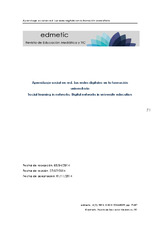Mostrar el registro sencillo del ítem
Aprendizaje social en red. Las redes digitales en la formación universitaria
| dc.contributor.author | Gómez García, Melchor | |
| dc.contributor.author | Ruiz Palmero, Julio | |
| dc.contributor.author | Sánchez Rodríguez, José | |
| dc.date.accessioned | 2016-05-10T11:52:10Z | |
| dc.date.available | 2016-05-10T11:52:10Z | |
| dc.date.issued | 2015 | |
| dc.identifier.issn | 2254-0059 | |
| dc.identifier.uri | http://hdl.handle.net/10396/13512 | |
| dc.description.abstract | Las redes sociales ofrecen grandes posibilidades de comunicación e interacción social en los nuevos ciudadanos del siglo XXI, pero lo hacen con propiedades y funcionalidades muy distintas. Desde la formación universitaria podemos recoger algunas de estas características para fortalecer la actividad de aprendizaje a través de una mejor o mayor comunicación. Pero no todas las redes son iguales ni todas sirven para el entorno educativo. Elementos referidos a la seguridad, la privacidad o el control de la actividad de los usuarios son fundamentales a la hora de plantearnos su integración como una herramienta académica formal. Las redes sociales de carácter vertical son una excelente herramienta de enseñanza-aprendizaje para las instituciones de educación superior, y veremos que algunas universidades ya las están poniendo en uso en sus planes de formación e investigación. En estas líneas presentaremos algunas de las ventajas que ofrecen en su integración formal a la vez que adelantaremos las dificultades que debemos salvar para alinear la actividad con la red y nuestros objetivos docentes. | es_ES |
| dc.description.abstract | Social networks offer great potential for communication and social interaction in the new citizens of the XXI century, but social networks do it with different properties and functionalities. From university we can incorporate some of these features to strengthen the learning activity through a better communication. But not all networks are equal and not all networks can be used in educational environment. Items like security, privacy or activity control are fundamental to their integration as a formal academic tool. The vertical social networks are a great tool for teaching and learning in higher education institutions, and many universities use it for training and research programs. We will present some of the advantages they offer in formal training. At the same time we will advance the difficulties to align the social network activity with our teaching objectives. | es_ES |
| dc.format.mimetype | application/pdf | es_ES |
| dc.language.iso | spa | es_ES |
| dc.publisher | Universidad de Córdoba, UCOPress | es_ES |
| dc.rights | https://creativecommons.org/licenses/by/3.0/ | es_ES |
| dc.source | Edmetic 4(2), 71-87 (2015) | es_ES |
| dc.subject | Red de información | es_ES |
| dc.subject | Aprendizaje social | es_ES |
| dc.subject | Educación | es_ES |
| dc.subject | Educación tecnológica | es_ES |
| dc.subject | Information network | es_ES |
| dc.subject | Social learning | es_ES |
| dc.subject | Education | es_ES |
| dc.subject | Technological education | es_ES |
| dc.title | Aprendizaje social en red. Las redes digitales en la formación universitaria | es_ES |
| dc.title.alternative | Social learning network. Digital networks in university education | es_ES |
| dc.type | info:eu-repo/semantics/article | es_ES |
| dc.relation.publisherversion | http://www.uco.es/ucopress/ojs/index.php/edmetic/index | es_ES |
| dc.rights.accessRights | info:eu-repo/semantics/openAccess | es_ES |

